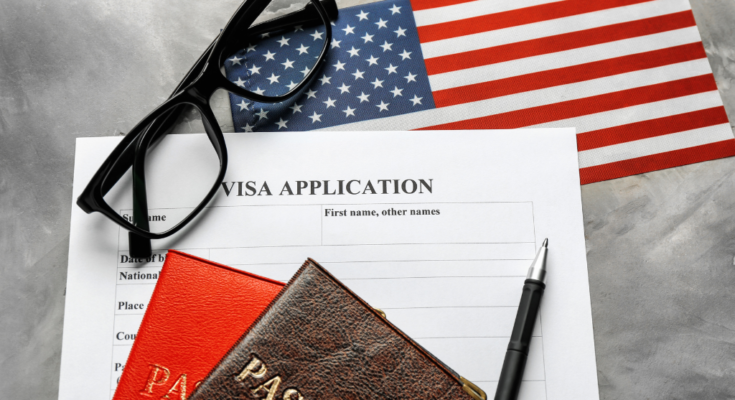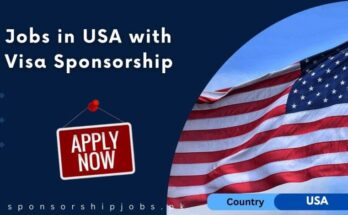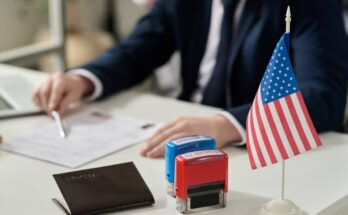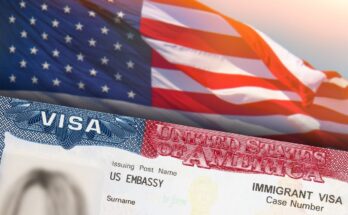Traveling to the United States is a dream for millions worldwide, with countless opportunities to explore cultural landmarks, visit family, or attend events. However, entering the U.S. requires a valid visa, and for tourists, the B-2 visa is the most appropriate option.
Yet, securing this visa can be challenging for immigrants, particularly if they face financial or eligibility constraints. In such cases, visa sponsorship can significantly increase their chances of approval.
This article will guide you through everything you need to know about the U.S. tourist visa process, including the critical role of sponsorship.
Understanding the USA Tourist Visa (B-2 Visa)
The U.S. tourist visa, formally known as the B-2 visa, is a non-immigrant visa that permits travelers to visit the United States temporarily. The primary purpose of this visa includes tourism, visiting family or friends, attending social functions, or receiving medical treatment. It’s a flexible visa designed for short-term visits but does not allow work or study.
Benefits of the B-2 Visa:
- Freedom to travel across the U.S.
- Opportunity to visit loved ones or attend important events
- Access to U.S. healthcare for medical purposes (with certain conditions)
However, like all U.S. visas, applying for a tourist visa involves meeting strict eligibility criteria.
Eligibility Requirements for a Tourist Visa
To qualify for a B-2 visa, applicants must demonstrate that they are visiting for a temporary purpose and intend to return to their home country after the visit.
Key Requirements Include:
- Valid Passport – Your passport should be valid for at least six months beyond your planned stay.
- Purpose of Travel – You need to clearly explain why you are traveling, whether for tourism, family visits, or medical treatment.
- Financial Stability – You must show that you have the financial means to cover your expenses in the U.S.
- Ties to Home Country – Applicants must prove strong ties to their home country, such as employment, property ownership, or family responsibilities.
Meeting these criteria is vital, but sponsorship can greatly strengthen your case if you’re facing financial limitations.
What is Visa Sponsorship?
Visa sponsorship occurs when a U.S. resident, organization, or company supports your application by guaranteeing that they will assist with your travel and living expenses. Sponsors help demonstrate to the U.S. government that you have adequate financial backing and a legitimate reason for your visit.
Types of Sponsorship:
- Personal Sponsorship: Provided by family or friends residing in the U.S.
- Organizational Sponsorship: Typically offered by institutions for specific events, like conferences or cultural exchanges.
A strong sponsorship can help assure visa officers that you will not become a financial burden to the U.S. government.
How Visa Sponsorship Helps in Tourist Visa Applications
One of the biggest hurdles for tourist visa applicants is proving they have the financial resources for their trip. A sponsor can help alleviate this concern by providing documentation that they will financially support you during your stay.
Key Advantages of Sponsorship:
- Financial Assurance: The sponsor can provide evidence of their income and assets to prove they can support your travel needs.
- Ties to the U.S.: A sponsor who is a lawful resident or U.S. citizen helps establish your legitimate connection to someone in the country.
- Reduced Risk of Denial: Having a sponsor strengthens your case, making visa officers more likely to approve your application.
Types of Sponsors for a Tourist Visa
A sponsor can be anyone who has a legal right to reside in the U.S. and sufficient financial means to support your visit. Common types of sponsors include:
- Family Members: Relatives are often the most common sponsors, especially for applicants visiting family.
- Friends or Acquaintances: Sponsors who are not related to you must provide additional documentation explaining their relationship with you.
- Organizations: Some non-profits or cultural institutions may sponsor applicants attending specific programs or events.
Each type of sponsor must provide key documentation, including financial records and a letter of invitation.
Sponsor’s Responsibilities and Obligations
Being a sponsor is a serious commitment that involves both financial and legal responsibilities.
Key Responsibilities Include:
- Providing Financial Support: Sponsors must show they can cover your travel, accommodation, and other expenses.
- Submitting Supporting Documents: These may include bank statements, tax returns, and a signed affidavit of support (Form I-134).
- Ensuring Accurate Information: False or misleading information can lead to visa denial and legal consequences for both the sponsor and the applicant.
With a reliable sponsor, applicants can significantly enhance their chances of securing a U.S. tourist visa.
How to Apply for a USA Tourist Visa with Sponsorship
Applying for a U.S. tourist visa involves a multi-step process. If you have a sponsor, you’ll need to provide their documents alongside your own during the application and interview phases.
Step-by-Step Process:
Complete the DS-160 Form:
- The DS-160 is the official online non-immigrant visa application form. It collects personal information, travel plans, and sponsorship details.
- After completing the form, you’ll receive a confirmation page with a barcode, which you’ll need to bring to your visa interview.
Pay the Visa Application Fee:
- The current fee for a U.S. tourist visa is $185 (subject to change). Keep the payment receipt for verification during your interview.
Schedule the Interview:
- Book an appointment at the nearest U.S. embassy or consulate.
- In many countries, wait times can be long, so it’s essential to schedule early.
Gather Your Documentation:
- Prepare personal documents such as your passport, DS-160 confirmation page, and travel itinerary.
- Collect sponsorship documents, including the sponsor’s bank statements, proof of income, and a letter of support.
Attend the Interview:
- Be prepared to explain your travel purpose, funding, and intent to return to your home country.
- The visa officer may also ask questions about your sponsor’s background and financial ability.
Documents Needed for Tourist Visa Application
A complete application package strengthens your case and increases your chances of approval. Below are the essential documents for both the applicant and the sponsor.
For the Applicant:
- Valid passport (at least six months beyond your planned stay)
- Completed DS-160 confirmation page
- Payment receipt for the visa fee
- Travel itinerary, including flight and accommodation bookings
- Evidence of ties to your home country (employment letter, property deeds, etc.)
For the Sponsor:
- Letter of Invitation: The sponsor must write a formal letter inviting you to the U.S., detailing the purpose and duration of your visit.
- Affidavit of Support (Form I-134): This form legally declares that the sponsor will financially support you.
- Financial Documents: Bank statements, tax returns, and proof of income should be provided to verify financial stability.
Submitting organized and clear documents can make a positive impression on the visa officer.
Tourist Visa Interview Process and Tips
The visa interview is a crucial part of the application process. It’s your chance to explain your travel plans, provide evidence of financial stability, and demonstrate your intent to return home after your visit.
Common Interview Questions:
- What is the purpose of your visit?
- How long do you plan to stay in the U.S.?
- Who is sponsoring your trip, and what is your relationship with them?
- What ties do you have to your home country?
Tips for a Successful Interview:
- Be honest and concise in your responses.
- Bring all required documents, including sponsorship materials.
- Dress appropriately and maintain a professional demeanor.
- Avoid giving unnecessary details that might create confusion.
The key to success is confidence and preparation. Practice answering common questions beforehand to reduce nervousness.
How Long Does It Take to Process a Tourist Visa?
Processing times for U.S. tourist visas can vary depending on the applicant’s country and the workload at the consulate.
Typical Processing Stages:
- Application Review: Once you submit your DS-160 form, your application enters the processing queue.
- Interview Appointment: Depending on demand, interview appointments may take weeks or even months to schedule.
- Post-Interview Processing: If approved, your visa will be issued within 5 to 10 business days. In some cases, additional administrative processing may be required, delaying the issuance.
It’s advisable to apply well in advance of your planned travel date to account for any potential delays.
Common Reasons for Tourist Visa Denial
A U.S. tourist visa application can be denied for various reasons. Understanding these reasons can help you avoid costly mistakes.
Common Denial Factors:
- Insufficient Financial Documentation: If the applicant or sponsor fails to provide evidence of adequate funds, the application may be rejected.
- Weak Ties to Home Country: Visa officers want assurance that applicants intend to return home. Without strong ties, such as employment or family, your application may be denied.
- Incorrect or Incomplete Application: Errors on the DS-160 form, missing documents, or failure to provide truthful answers can result in rejection.
Applicants who are denied can reapply, but it’s essential to address the issues that led to the previous denial.
How to Improve Your Chances of Visa Approval
If you want to maximize your chances of success, there are several strategies to follow when preparing your application and attending the interview.
Best Practices:
- Ensure Complete Documentation: Double-check all your paperwork and bring both personal and sponsorship-related documents.
- Demonstrate Financial Stability: Whether through your finances or your sponsor’s support, make sure you can show sufficient funds to cover your stay.
- Highlight Strong Ties to Home Country: Bring evidence such as employment contracts, business ownership documents, or family records.
By proactively addressing potential concerns, you can leave a positive impression on the visa officer.
Tourist Visa Duration and Extension Options
Tourist visas typically allow a stay of up to six months in the U.S., but this period can vary based on the officer’s discretion at the port of entry.
Duration Details:
- Initial Stay: You are generally permitted to stay for six months unless otherwise specified on your I-94 form.
- Extension: If you need to stay longer, you can apply for an extension by submitting Form I-539 to U.S. Citizenship and Immigration Services (USCIS).
Important Note: Overstaying a tourist visa can lead to severe consequences, including bans on future U.S. entry. Always comply with the terms of your visa.
Conclusion
Securing a U.S. tourist visa can be a complex process, particularly for immigrants with limited financial resources. However, sponsorship can play a crucial role in strengthening your application by demonstrating financial stability and legitimate travel intentions. By understanding the application process, gathering the right documents, and preparing for the interview, you can significantly improve your chances of approval. Whether you’re visiting family, attending an event, or simply exploring the U.S., careful planning is the key to a successful trip.



